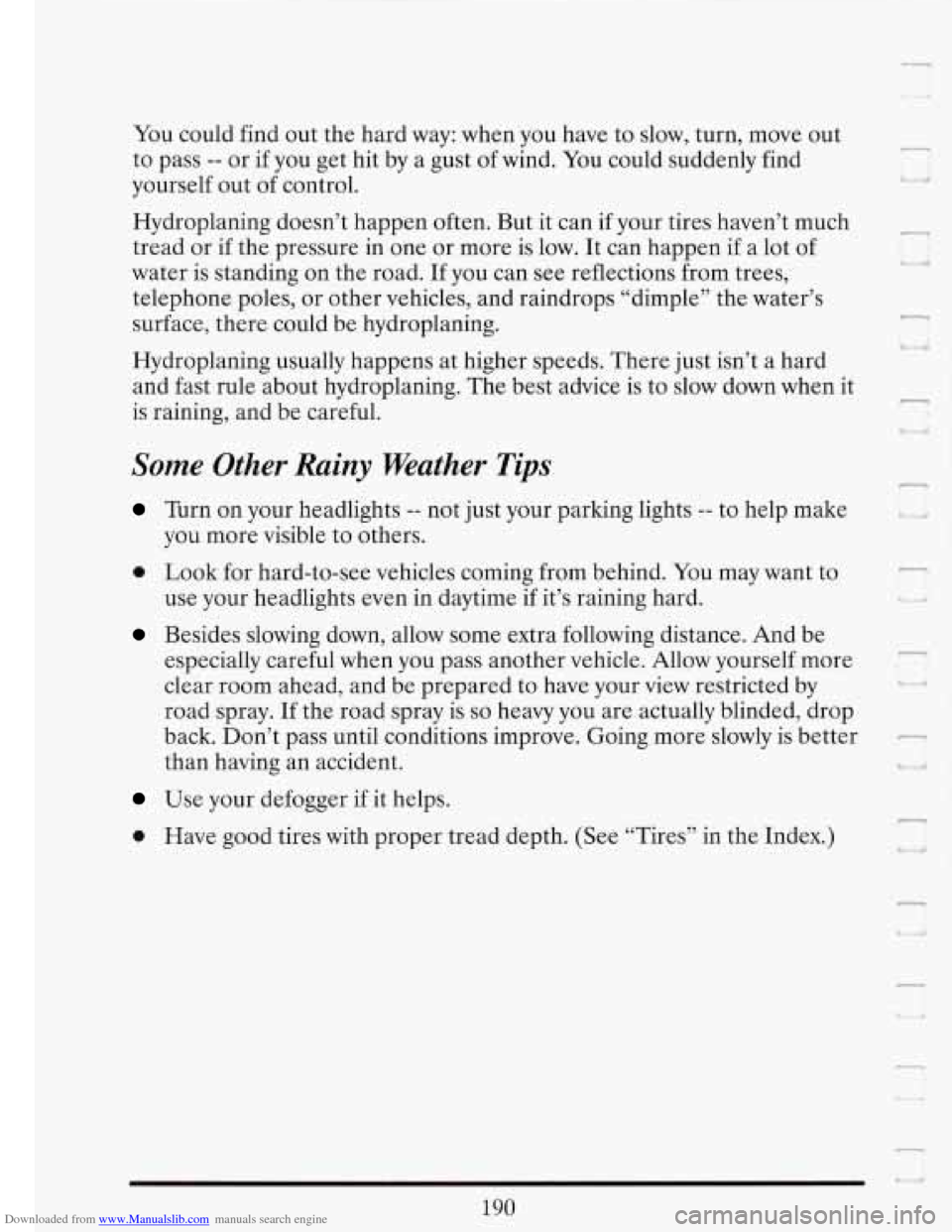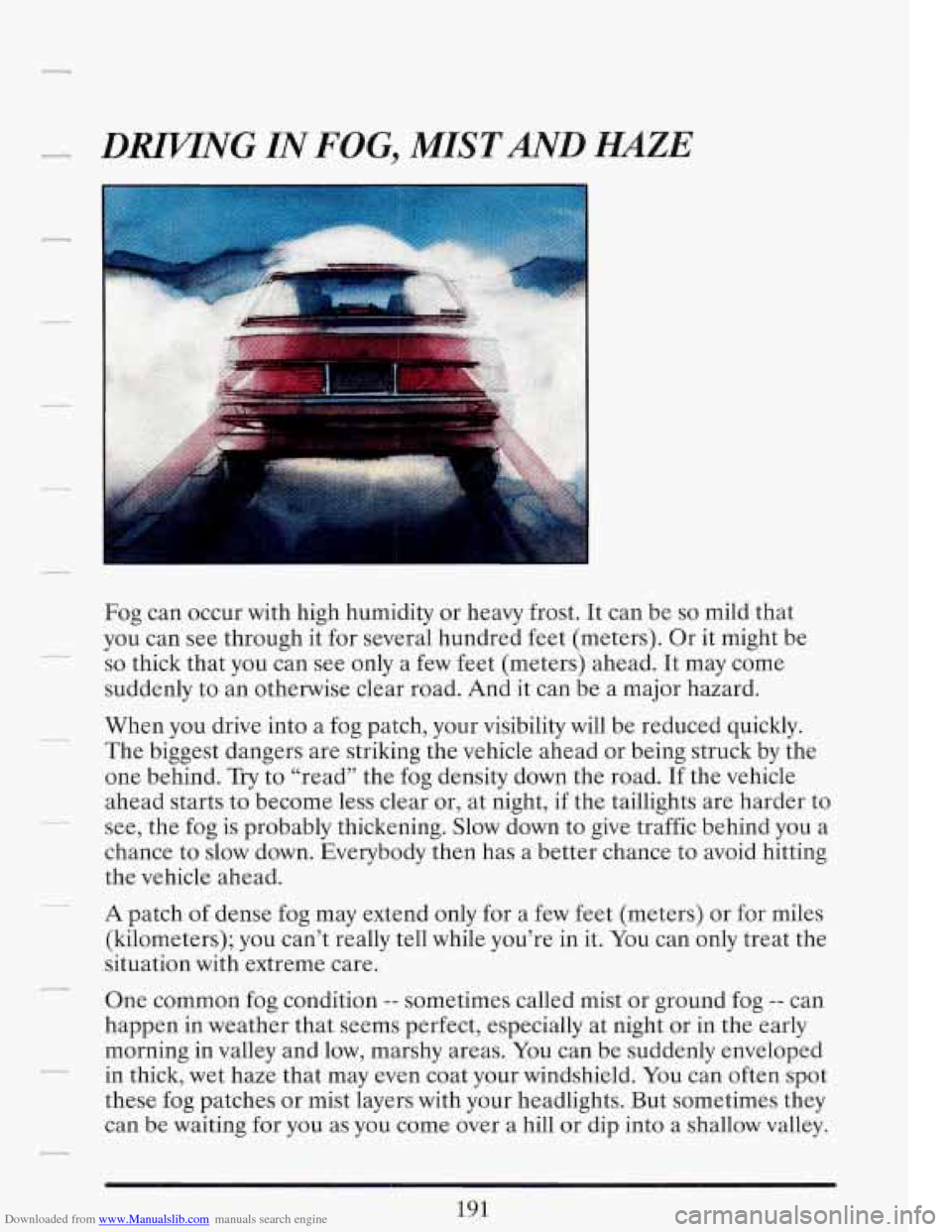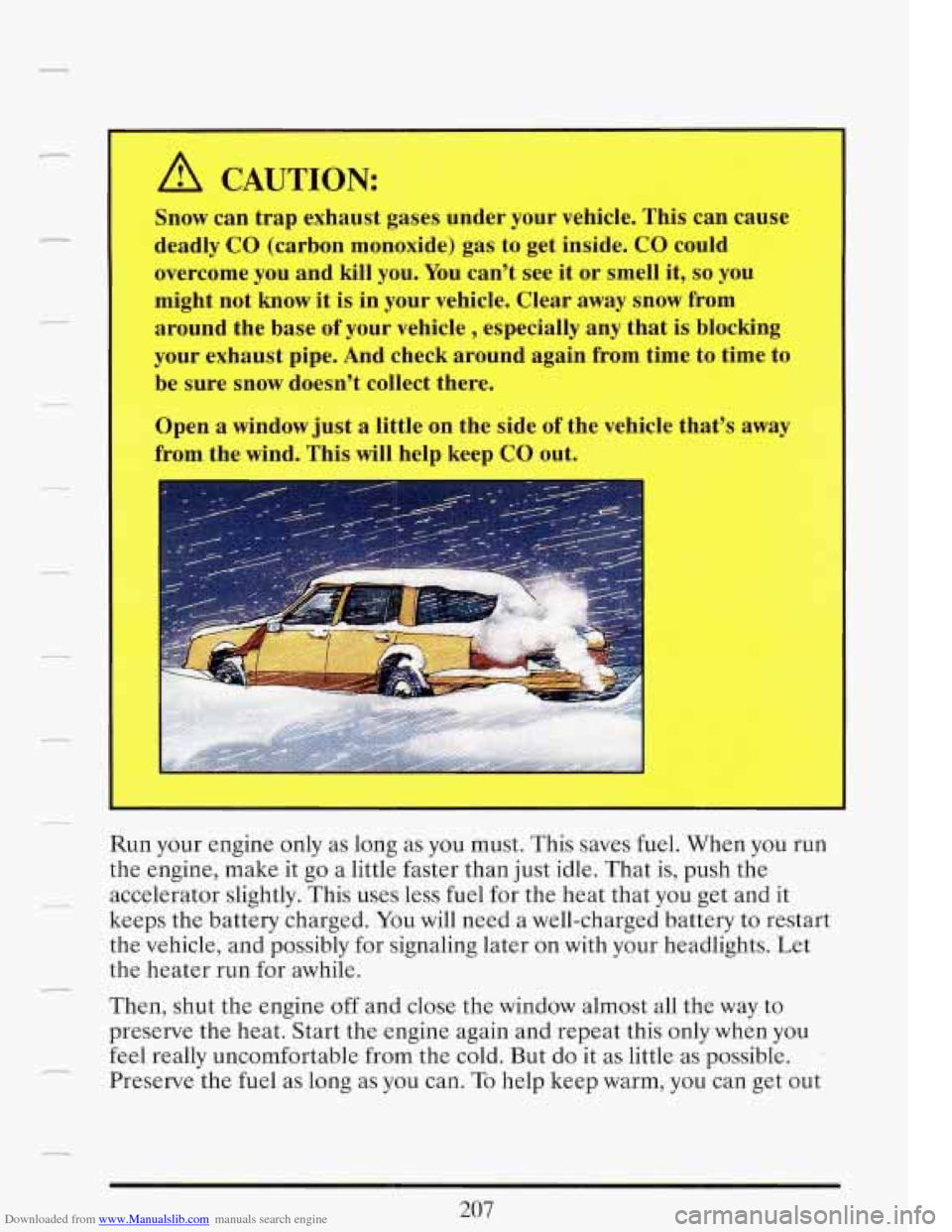1993 CADILLAC FLEETWOOD headlights
[x] Cancel search: headlightsPage 204 of 386

Downloaded from www.Manualslib.com manuals search engine You could find out the hard way: when you have to slow, turn, move out
to pass
-- or if you get hit by a gust of wind. You could suddenly find
yourself out of control.
Hydroplaning doesn’t happen often. But it can if your tires haven’t much
tread or if the pressure in one or more is low. It can happen if a lot of
water is standing on the road.
If you can see reflections from trees,
telephone poles, or other vehicles, and raindrops “dimple” the water’s
surface, there could be hydroplaning.
Hydroplaning usually. happens at higher speeds. There just isn’t a hard
and fast rule about hydroplaning. The best advice is to slow down when it
is raining, and be careful.
Some Other Rainy Weather Tips
Turn on your headlights -- not just your parlung lights -- to help make
you more visible to others.
0 Look for hard-to-see vehicles coming from behind. You may want to
use your headlights even in daytime if it’s raining hard.
Besides slowing down, allow some extra following distance. And be
especially careful when you pass another vehicle. Allow yourself more
clear room ahead, and be prepared to have your view restricted by
road spray.
If the road spray is so heavy you are actually blinded, drop
back. Don’t pass until conditions improve. Going more slowly is better
-
than having an accident. I
L1
I
Use your defogger if it helps.
0 Have good tires with proper tread depth. (See “Tires” in the Index.)
-
Y
190 I
Page 205 of 386

Downloaded from www.Manualslib.com manuals search engine DRZKNG IN FOG, MISTAND HAZE
Fog can occur with high humidity or heavy frost. It can be so mild that
you can see through it for several hundred feet (meters). Or it might be
so thick that you can see only a few feet (meters) ahead. It may come
suddenly to an otherwise clear road. And it can be a major hazard.
When you drive into a fog patch, your visibility will be reduced quickly.
The biggest dangers are striking the vehicle ahead or being struck by the
one behind.
Try to “read” the fog density down the road. If the vehicle
ahead starts to become less clear or, at night,
if the taillights are harder to
see, the fog is probably thickening. Slow down to give traffic behind you a
chance to slow down. Everybody then has a better chance to avoid hitting
the vehicle ahead.
A patch of dense fog may extend only for a few feet (meters) or for miles
(kilometers); you can’t really tell while you’re in it.
You can only treat the
situation with extreme care.
One common fog condition
-- sometimes called mist or ground fog -- can
happen in weather that seems perfect, especially at night or in the early
morning in valley and low, marshy areas.
You can be suddenly enveloped
in thick, wet haze that may even coat your windshield.
You can often spot
these fog patches or mist layers with your headlights. But sometimes they
can
be waiting for you as you come over a hill or dip into a shallow valley.
191
Page 221 of 386

Downloaded from www.Manualslib.com manuals search engine A CAUTION:
Snow can trap exhaust gases under your vehicle. This can cause
deadly CO (carbon monoxide) gas to get inside. CO could
overcome you and kill you. You can’t see it or smell it,
so you
might not know it is in your vehicle. Clear away snow from
around the base
of your vehicle , especially any that is blocking
your exhaust pipe. And check around again from time to time to
be sure snow doesn’t collect there.
Open a window just a little on the side
of the vehicle that’s away
from the wind. This will help keep CO out.
Run your engine only as long as you must. This saves fuel. When you run
the engine, make it go a little faster than just idle. That is, push the
accelerator slightly. This uses less fuel for the heat that you get and it
keeps the battery charged. You
will need a well-charged battery to restart
the vehicle, and possibly for signaling later
on with your headlights. Let
the heater run for awhile.
207
Then, shut the engine off and close the window almost all the way to
preserve the heat. Start the engine again and repeat this only when you
feel really uncomfortable from the cold. But
do it as little as possible.
Preserve the fuel as long as you can. To help keep warm, you can get out
Page 330 of 386

Downloaded from www.Manualslib.com manuals search engine n
I
I-
1 E
I
rm
i
I
UNDERHOOD (U/H) ELECTRICAL CENTER 1 - BODY 1 (50 AMP) - #45 PWR. DR. LOCK RELAY - #36 TRUNK PULL-DOWN - #37 STOP/HAZARD - #38 RECLINE SW. . . . . - -. . . - - . . . - #39 PWR. LUMBAR
- #3 PWR. SEAT CIRCUIT BREAKER - $4 REAR DEFOG RELAY CIRCUIT
- #40 HEATED SEAT
BREAKER
- #44 MIRROR DEFOG 2 - BODY 2 (50 AMP) - #26 I/P-PWR. ANTENNA - #27 l/P-DELAYED INTERIOR
- #28 WFRONT CIGAR - #29 I/P-REAR CIGAR
- #21 IIP-RAP ACCESSORY RELAY - #30 I/P-HVAC CNTRL. HEAD
- #22 I/P-HVAC PWR. MOD. - #23 WTRUNK RELEASE - #9 I/P-RADIO - #10 I/P-RAP ACCESSORY - #31 I/P-TRACTION CNTRL.
LIGHTS (DIL) - #33 GP-TELTALE - #34 I/P-CCM 2 - #35 I/P-PWR. DR. LOCK SW. - #I8 U/H-AIR PUMP - #2 CIRCUIT BREAKER I/P-RAP
PWR. RELAY
3 - IGN 1 (50 AMP) - #E I/P-RETAINED ACCESSORY
- #6 I/P-TURN FLASHER - #24 I/P-CRANK - #15 FAIR BAG
PWR. (RAP) - #11 IWTELTALE
- #14 VP-CENTRAL CNTRL. MOD. 12 - PARK LIGHTS (20 AMP) (CCM) - #4 F/L-PARK LIGHTS - #13 I/P-CHIME - #7 I/P-TRACTION CNTRL. - #I3 U/H-INJECTORS - #42 I/PI-DIMMER - #I4 U/H-ENGINE
CNTRL. MOD. - #43 I/P-REAR TAIL LIGHTS
- #5 F/L-FORWARD LIGHTS - #41 I/P-CORNERING LIGHTS
- IN-LINE CONCEALED I/P-REMOTE (ECW
- IGNITION COIL 4 - IGNS 3 (40 AMP) - #I6 I/P-CRUISE - #I7 I/P-HEATED SEATS - #18 I/P-CCM IGNITION - #19 WRAP PWR. RELAY - #20 I/P-HVAC CNTRL. HEAD - #17 U/H-COOLING FAN RELAY
KEYLESS ENTRY RECEIVER 5 - ABS (50 AMP) - ANTILOCK BRAKE SYSTEM/
TRACTION CNTRL.
(ABSKC)
HYDRAULIC MODULATOR
6- NOTUSED 7 - PRIMRY CLG FAN (50 AMP)
8 - SCNDRY CLG FAN (50 AMP)
9 - LEVEL CNTRL. (30 AMP)
- PRIMARY COOLING FAN RELAY
- SECONDARY COOLING FAN RELAY
- #15 U/H-ELECTRONIC LEVEL
10 - FUEL PUMP (20 AMP)
11 - HEADLlGHTSlHORNS 130 AMP)
CNTRL. (ELC)
- #16 U/H-FUEL PUMP
- #I F/L-HORNRELAY ' - #2 F/L-HEADLIGHTS RELAY - #5 CIRCUIT BREAKER
I/P-HEADLIGHTS
13 - INJECTORS (IO AMP) - FUEL INJECTORS - ENGINE CNTRL. MOD. (ECM)
- EXHAUST GAS RECIRCULATION 14 - EGR/PCM (IGN) (IO AMP)
(EGR) VALVE - AIR PUMP RELAY - PURGE CANISTER 15 - LEVEL CNTRL. (20 AMP) - ELECTRONIC LEVEL CNTRL. (ELC)
- ELC COMPRESSOR/RELAY HEIGHT SENSOR
ASSEMBLY
16- FUEL PUMP (10 AMP) - ENGINE CNTRL. MOD. (ECM) - FUEL PUMP RELAY - FUEL PUMP/OIL PRESSURE SW.
- SECONDARY COOLING FAN RELAY - COOLING FANS CNTRL. RELAY
- AIR PUMP RELAY
17 - COOLING FANS (1 0 AMP)
18
- AIR PUMP (20 AMP)
A- NOT USED B - COOLING FANS CNTRL. RELAY
C
- A/C DISABLE RELAY - COOLING FAN CNTAL. RELAY
- AIR COND. DISABLE RELAY D - FUEL PUMP RELAY - FUEL PUMP RELAY
-
9 I
316
Page 334 of 386

Downloaded from www.Manualslib.com manuals search engine -' h
Headlights
The headlight wiring is protected by a circuit breaker in the light switch.
An electrical overload will cause the lights to go on and off, or in some
cases to remain off.
If this happens, have your headlight wiring checked
right away.
Windshield Wipers
The windshield wiper motor is protected by a circuit breaker and a fuse.
If the motor overheats due to heavy snow, etc., the wiper will stop until
the motor cools.
If the overload is caused by some electrical problem and
not snow, etc., be sure to get it fixed.
Power Windows and Other Power Options
Circuit breakers in the fuse panel protect the power windows and other
power accessories. When the current load is too heavy, the circuit breaker
opens and closes, protecting the circuit until the problem is fixed or goes
away.
BULB CUT
You can get these from your Cadillac dealer.
DESCRIPTION BULB NO.
Ash Tray Illumination .................................. 1445
Backup Lights
......................................... 2057
Center High Mounted Stop Light
........................ 1141
Cornering Light
....................................... 2057
Courtesy Light
- Front Door ............................ S214-2
Courtesy Light
- Rear Door ............................. S214-2
Courtesy/Map Light
..................................... 192
Front Parking
& Directional Signal .................... 2057NA
Front Side Marker Light
................................. ,194
GloveBox
............................................. 194
Headlight High Beam ...................... 906MB4 (H2990 4)
Headlight Low Beam ....................... 905/HB3 (K1790 3)
License Plate Light
..................................... 194
Parking Light
......................................... 2057
320